|
The daffodil never fails because most are perfectly adapted to the British climate which tends to be cool and damp in winter. Your bulbs can be planted as soon as autumn begins, although do wait for cold weather before planting your tulips (see 'things to do'). Daffodils take an average of 12 weeks to send the flowering shoot up and the bud will lie beneath the soil from Christmas onwards before emerging and flowering at the correct time. Flowering times vary, so it is possible to have daffodils in flower from December until May. The ‘up to 6 months of daffodils’ collection offers six varieties, which will really help stretch the flowering period. They’re also deer and rabbit proof.
Early Arrivals
 The earliest of all is often Narcissus 'Rijnveld's Early Sensation’, a clear yellow trumpet daffodil which can appear before Christmas in mild winters. This daffodil, which only became widely available twenty years ago, was actually bred in Britain by F. Herbert Chapman, pre-1943, but was rechristened in the 1960’s. This glorious forerunner to spring reappears year after year, but benefits from being divided and replanted every three years or so. The clear yellow flowers are large, so stand out well, and they resist the vagaries of the weather - reaching just a foot in height. 'Rijnveld's Early Sensation’ can be grown in larger containers, or in the garden, and it cuts well too. The earliest of all is often Narcissus 'Rijnveld's Early Sensation’, a clear yellow trumpet daffodil which can appear before Christmas in mild winters. This daffodil, which only became widely available twenty years ago, was actually bred in Britain by F. Herbert Chapman, pre-1943, but was rechristened in the 1960’s. This glorious forerunner to spring reappears year after year, but benefits from being divided and replanted every three years or so. The clear yellow flowers are large, so stand out well, and they resist the vagaries of the weather - reaching just a foot in height. 'Rijnveld's Early Sensation’ can be grown in larger containers, or in the garden, and it cuts well too.
Also Early
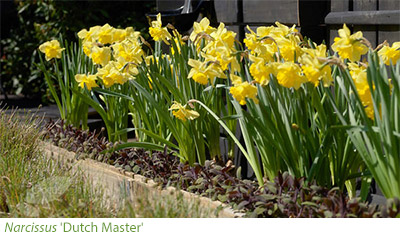
A little later, with bigger, brasher and brighter flowers, is ‘Dutch Master’ an award-winning variety from 1938. This has long wide trumpets that flare on the ends and turn up like a starched taffeta petticoat. It’s showy and often grown for cut flower. It’s also fragrant, as many narcissi are. ‘Spring Dawn’ (1986) is a much subtler thing, with creamy outers surrounding a soft lemon, frilly-edged cup. Both can flower in January in clement years and both have been performing in gardens for decades - as has the bright yellow ‘King Alfred’ grown since the 1880’s. ‘Carlton’ is another yellow, but with more-refined long trumpets. It’s also stood the test of time, having been around since the 1920’s. These older varieties are garden stalwarts, coming back year after year.
Pale Lovelies
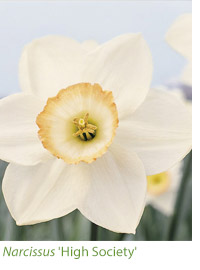 Not everyone loves a blast of bright yellow and there are plenty of white and cream varieties to mix among spring-flowering hellebores or plant under shrubs and trees. ‘Salome’ is an unusual and reliable daffodil with cream flowers that develop soft apricot-orange trumpets as the flowers mature. ‘High Society’ has a large flower with a white shallow cup that turns greenish yellow and produces an orange rim. Not everyone loves a blast of bright yellow and there are plenty of white and cream varieties to mix among spring-flowering hellebores or plant under shrubs and trees. ‘Salome’ is an unusual and reliable daffodil with cream flowers that develop soft apricot-orange trumpets as the flowers mature. ‘High Society’ has a large flower with a white shallow cup that turns greenish yellow and produces an orange rim.
‘Ice Follies’ has a flat, frilly wide-open cup that colours up from cream to lemon as the flowers mature, backed by cream-white outers. This strongly growing narcissus, over 70 years old, can be grown in borders, or in grass, and it’s one the strongest pale daffodils. ‘Thalia’, a three-headed pure-white heritage daffodil, has charm and elegance in spades, but this triandus type needs a warm position to thrive so you may need to containerise ‘Thalia’ in colder gardens.

‘Silver Chimes’, a late-flowering, foot-high tazetta, is very fragrant and probably the best garden tazetta of all. The neatly regular, white outer petals surround a small lemon cup so this delicate daffodil is very easy on the eye. ‘Sailboat’ shares this lemon-meringue colouring but the petals on this foot-high jonquil are slightly swept back. If you want an all-yellow jonquil, opt for ‘Sabrosa’. Both flower mid- to late, producing fragrant flowers on foot-high stems.
Wildings For Naturalising
Some daffodils are strong enough to push through grass, but the best way to help them is to take a garden spade and cut a triangle with sides about a foot in length - so you're lifting a three-inch layer of turf. Slide the spade into the triangle and lift two sides, to create a flap. Get a garden fork and break up the soil underneath the triangle and place five bulbs together and then pull the flap of turf about to break up the sward and then replace. You won’t be able to mow these areas until June at the earliest because the foliage has to replenish the bulb and die down.
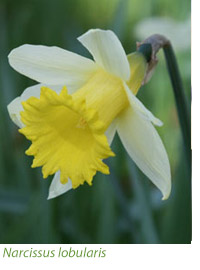 The most wild-looking daffodil is Narcissus lobularis, a native British species commonly called the Lent Lily because it flowers in March. Now commercially raised, the pale yellow outers are slightly twisted and surround a slightly darker trumpet. This species daffodil should be left to self-seed because this is how it spreads - and not by bulbils. The heritage variety ‘W.P. Milner’ has a similar informal old-fashioned look, and it was raised before 1869. Both fold their heads rather shyly, rising to ten inches or so, and both are perfect for creating that country feel. N. obvallaris is an all yellow species daffodil known as the Tenby daffodil, although it grows on the western side of Britain. This is the daffodil that inspired William Wordsworth’s famous line, a host of golden daffodils, in I Wandered Lonely as a Cloud. The daffodils grew on the shores of Ullswater in the Lake District. The most wild-looking daffodil is Narcissus lobularis, a native British species commonly called the Lent Lily because it flowers in March. Now commercially raised, the pale yellow outers are slightly twisted and surround a slightly darker trumpet. This species daffodil should be left to self-seed because this is how it spreads - and not by bulbils. The heritage variety ‘W.P. Milner’ has a similar informal old-fashioned look, and it was raised before 1869. Both fold their heads rather shyly, rising to ten inches or so, and both are perfect for creating that country feel. N. obvallaris is an all yellow species daffodil known as the Tenby daffodil, although it grows on the western side of Britain. This is the daffodil that inspired William Wordsworth’s famous line, a host of golden daffodils, in I Wandered Lonely as a Cloud. The daffodils grew on the shores of Ullswater in the Lake District.
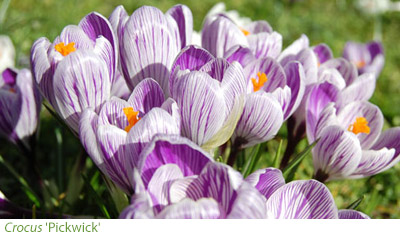
You can also naturalise a strong March-flowering cream-white called ‘Curlew’. This American variety, part of a bird series, fades to white and does well in grass because it bulks up really well. If you want something snappier try ‘Jetfire’, from the same American raiser, for the small yellow flowers have an almost red trumpet, although it does take time to develop. Purple Dutch crocuses, such as ‘Pickwick’ and ‘Remembrance’, flower at the same time and also do well in grass.
Perfect in a Container
 Miniature daffodils, less than ten inches in height, have only been around for the last sixty or seventy years. They arose by accident when Alec Gray, a Cornish daffodil-grower for the cut-flower trade, undertook a breeding programme to hybridise early flowering Spanish daffodils with Cornish cut-flower varieties. He raised hybrids between 1927 and 1960, hoping to produce earlier cut-flower daffodils that would fetch a higher premium. All his seedlings proved to be short in stature, but he fell in love with them. He was the one who introduced the classic favourite ‘Tête à Tête’ (1949). The new offspring of this ever-popular culturar, 'Tete Rosette', is just as versatile and has a ruffled, double cup. Miniature daffodils, less than ten inches in height, have only been around for the last sixty or seventy years. They arose by accident when Alec Gray, a Cornish daffodil-grower for the cut-flower trade, undertook a breeding programme to hybridise early flowering Spanish daffodils with Cornish cut-flower varieties. He raised hybrids between 1927 and 1960, hoping to produce earlier cut-flower daffodils that would fetch a higher premium. All his seedlings proved to be short in stature, but he fell in love with them. He was the one who introduced the classic favourite ‘Tête à Tête’ (1949). The new offspring of this ever-popular culturar, 'Tete Rosette', is just as versatile and has a ruffled, double cup.
Miniatures, which are usually March-flowering, make great container plants, either grown in single blocks or mixed with contrasting scillas. ‘Minnow’ has neatly arranged cream outers surrounding a flared lemon cup. The New Zealand variety, ’Hawera’, looks very airy in a border, or a pot, because it usually has 5 flowers per stem and each flower has narrow petals that twist, surrounding an acorn-like cup in light lemon. Great with a refined muscari or Scilla siberica.

‘Jack Snipe’, a lemon and cream with swept-back petals, and the milk-white ‘Jenny’ are good grown singly in simple pots and and good in the garden. Or you could choose ‘Toto’, (a seedling partly from ‘Jenny’) which produces white stars with a lemon cup.
Garden Varieties for Cutting
 Some of the best cutting varieties contain button-like semi-double flowers and ‘Cheerfulness’ and ‘Yellow Cheerfulness’ are both superb garden daffodils that also pick well. ‘Sir Winston Churchill’, a sport of ‘Geranium’, is a more uneven double with white petals and an egg-yolk middle. ‘Bridal Crown’ is also in the same mould and being semi-double the flowers resist the weather and last longer whether in border or vase displaying. These all produce three to five flowers per stem. Some of the best cutting varieties contain button-like semi-double flowers and ‘Cheerfulness’ and ‘Yellow Cheerfulness’ are both superb garden daffodils that also pick well. ‘Sir Winston Churchill’, a sport of ‘Geranium’, is a more uneven double with white petals and an egg-yolk middle. ‘Bridal Crown’ is also in the same mould and being semi-double the flowers resist the weather and last longer whether in border or vase displaying. These all produce three to five flowers per stem.
The even showier ‘Tahiti’ bears one flower per stem, with the mid-yellow flowers spliced with almost-red linear petals. This Northern Irish variety was one of the first good garden double daffodils and it’s the best of this exotic Island Series. One to display at the local show, should you want to, to cut or to leave in the garden.
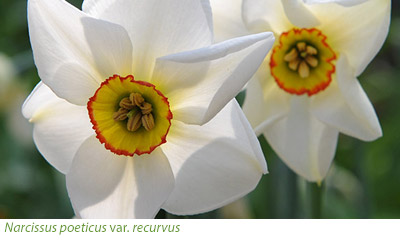
‘Lieke’, is also perfect for cutting, or for being left in the garden. An American-bred daffodil, named after the Dutch grower's daughter, it’s a white ‘poeticus’ type daffodil with a pale green cup and this is a new colour break. Or you could grow ‘Actaea’, a white pheasant’s eye with
a tiny yellow cup edged in red. This variety, over a hundred years old, will persist for years - being a great survivor. Narcissus poeticus var. recurvus is similar in colouring but slightly more informal in shape. Both can be naturalised in grass or grown in borders.
Plant these bulbs at twice the depth of the bulb and do allow the foliage to die down naturally. Don’t tie the foliage up, allow it to wither and die back naturally.
|
Things to do
 |
Plant a Clematis
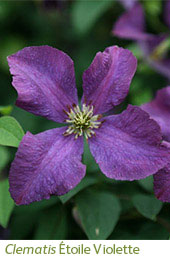
September is the very best month to get a clematis going. Clematis ‘Étoile Violette’ is a first-rate viticella that’s great scrambling up a trellis, or through a shrub, or up a rambling rose. Other good ones include ‘Polish Spirit’ and the double-blue ‘Flore Pleno’ (syn ‘Mary Rose’).
|
 |
Order Tulips
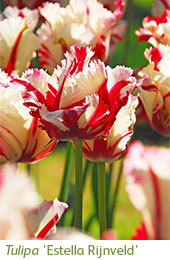
All your other bulbs can go in the ground now, but don’t plant tulips until after the end of October. Thats because lower temperatures prevent tulip fire, a debilitating fungal disease that covers the blooms and leaves with grey lesions.
|
 |
Take the Weight out of Roses

Trim the top growth on shrub, hybrid tea and floribunda roses once flowering finishes. Take each branch back by a third to prevent wind rock. You can then prune them again from Christmas onwards - English roses go back by a third, floribundas get taken back to eighteen inches and hybrid teas can go down to six or eight inches. For now though, just lighten some of the top growth.
|
 |
Give Leggy Plants a Trim
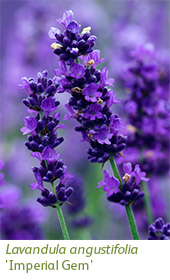
Perennials overwinter far better if there’s a tight mound of growth, so cut back helianthemums, perennial violas and even English lavenders as soon as possible so that they produce tight new growth.
|
 |
Have a Tidy Up

This is a good time to tidy up sheds and greenhouses, before the weather turns. If you spot any clusters of eggs or small cocoons leave them be. They are likely to be helpful predators such as spiders.
|
|
|
Essential Kit for September
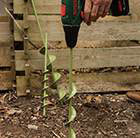
Bulb planting auger
from £8.99
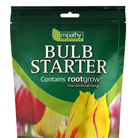
Bulb starter with rootgrow
£5.99

Haws leather gauntlet gloves - brown
£36.99

Scotts evergreen autumn lawn builder 8kg
£39.99

Pot brush
£8.99
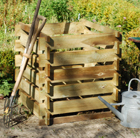
Compost box - FSC timber (small)
£59.99 £27.99
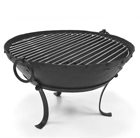
Barbecue / fire pit
£129.99
|
|

























